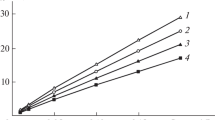Abstract
The electrical conductivity of sodium hydroxide–ammonium hydroxide solutions in the concentration ranges 1–3 M NaOH and 2–6 M NH4OH is studied in accordance with the content of the reagents in the solution and its temperature. It is shown that the electrical conductivity of the aforementioned system increases as the NaOH concentration increases, whereas, as the NH4OH concentration increases, the electrical conductivity decreases. The electrical conductivity of the system linearly is found to increase as the temperature of solution increases. This allows us to linearize the obtained dependences and to calculate the temperature coefficients of the electrical conductivity. The activation energy of the electrical conductivity is determined, which confirms the diffusion limitations of the charge transfer process in the system under study.



Similar content being viewed by others
REFERENCES
A. A. Palant and V. A. Bryukvin, “Electrochemical alternating current-assisted processing of metallic tungsten and molybdenum wastes in ammonia electrolytes,” Russ. Metall. (Metally), No. 2, 171–173 (2004).
A. A. Palant and V. A. Pavlovskii, “Physicochemical and manufacturing aspects of electrochemical processing of metallic tungsten wastes,” Tekhnol. Met., No. 11, 3–7 (2003).
A. A. Palant, R. A. Apriamkov, and V. A. Pavlovskii, “Electrochemical processing of metallic tungsten wastes,” Tsvetn. Met., No. 10, 47–49 (1995).
V. V. Shcherbakov, Yu. M. Artemkina, T. N. Pona-mareva, and A. D. Kirillov, “Electrical conductivity of the ammonia–water system,” Zh. Neorg. Khim. 54 (2), 321–323 (2009).
Handbook on Electrochemistry, Ed. by A. M. Sukhotin (Khimiya, Leningrad, 1981).
D. Dobosh, Electrochemical Constants: Handbook for Electrochemists (Mir, Moscow, 1980).
O. M. Levchuk, A. M. Levin, and V. A. Bryukvin, “Effect the tungsten(VI) and molybdenum(VI) ions on the electrical conductivity of ammonium hydroxide solutions,” Russ. Metall. (Metally), No. 3, 246–249 (2016).
O. M. Levchuk and A. M. Levin, “Electrical conductivity of ammonia solutions containing rhenium(VII),” Russ. Metall. (Metally), No. 9, 708–710 (2014).
O. M. Levchuk and A. M. Levin, “Effect of a dc magnetic field on the electrical conductivity of ammonia solutions containing tungsten(VI) and rhenium(VII) ions,” Russ. Metall. (Metally), No. 1, 22–25 (2015).
A. M. Levin, O. G. Kuznetsova, and M. A. Sevost’yanov, “Electrical conductivity of NaOH–NH4OH aqueous solutions at 20°C,” in Proceedings of the International Scientific and Practical Conference In the World of Science and Innovations (AETERNA, Ufa, 2017), Vol. 5, pp. 31–34.
A. Afifi and S. Aizen, Statistical Analysis: A Computer Oriented Approach (Academic Press, New York, 1979).
A. M. Levin, O. G. Kuznetsova, and M. A. Sevost’yanov, “Effect of temperature on the electrical conductivity of aqueous NaOH–NH4OH solutions,” in Proceedings of the International Scientific and Practical Conference on Modern Technologies in the World Research Area (AETERNA, Ufa, 2017), Vol. 5, pp. 33–36.
I. N. Maksimova, Pak-Chzhon Su, N. N. Pravdin, et al., Properties of Electrolytes (Metallurgiya, Moscow, 1987).
V. V. Shcherbakov, Z. Salem, V. I. Ermakov, and A. F. Vorob’ev, “Electrical conductivity and dielectric permeability of aqueous ammonium solutions,” Elektrokhimiya 28, 283–286 (1992).
L. T. Vlaev and V. G. Georgieva, “Activation energy of electrical conductivity of aqueous solutions of sulfuric acid, selenium acid, and potassium tellurate,” Elektrokhimiya 40 (6), 768–772 (2004).
A. M. Levin, O. G. Kuzhetsova, and M. A. Sevost’yanov, “Calculation of the activation energy of electrical conductivity of NaOH–NH4OH solutions,” in Proceedings of the International Scientific and Practical Conference on Innovative Technologies (AMI, Sterlitamak, 2018), pp. 46–50.
Funding
This study was performed in terms of state assignment no. 007-00129-18-00.
Author information
Authors and Affiliations
Corresponding author
Additional information
Translated by N. Kolchugina
Rights and permissions
About this article
Cite this article
Kuznetsova, O.G., Levin, A.M., Sevost’yanov, M.A. et al. Electrical Conductivity of Ammonia–Alkali Solutions and Its Activation Energy. Russ. Metall. 2019, 921–925 (2019). https://doi.org/10.1134/S0036029519090064
Received:
Revised:
Accepted:
Published:
Issue Date:
DOI: https://doi.org/10.1134/S0036029519090064




